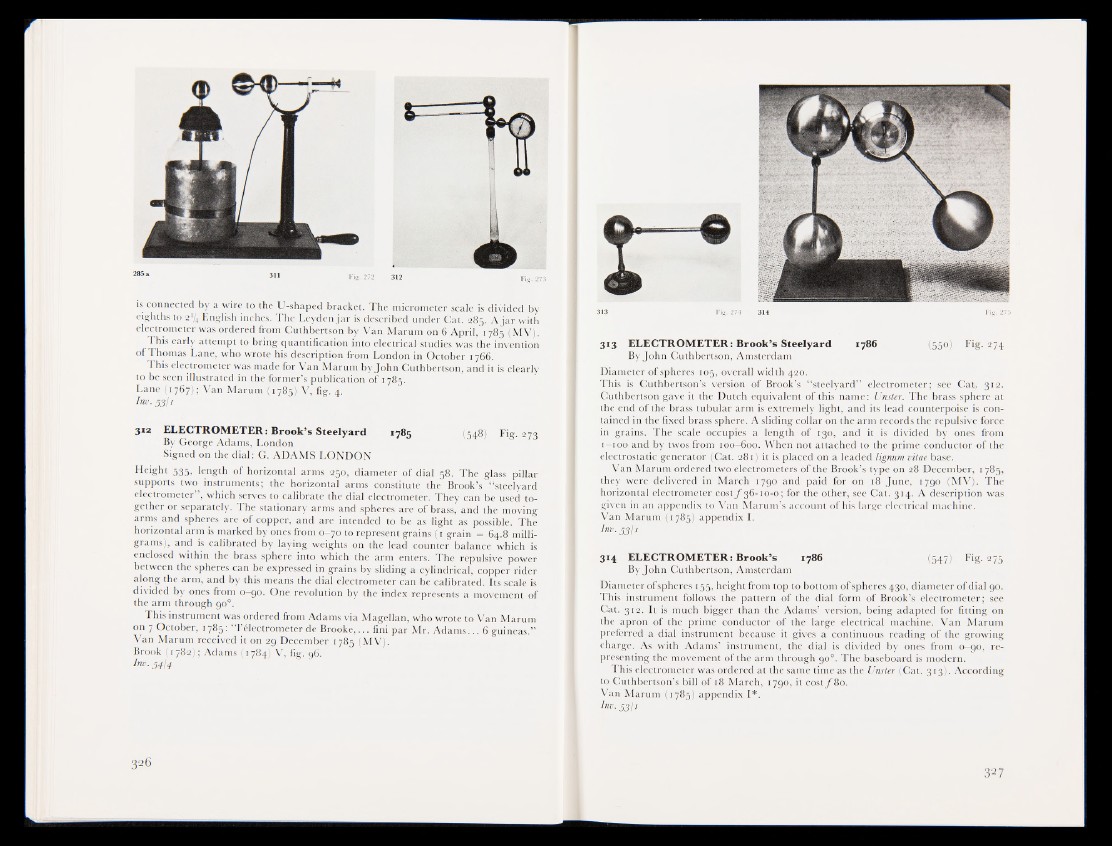
is connected by a wire to the U-shaped bracket. The micrometer scale is divided by
eighths to 2‘/4 English inches. The Leyden jar is described under Cat. 285. Ajar with
electrometer was ordered from Cuthbertson by Van Marum on 6 April, 1785 (MV)1
This early attempt to bring quantification into electrical studies was the invention
of Thomas Lane, who wrote his description from London in October 1766.
This electrometer was made for Van Marum by John Cuthbertson, and it is clearly
to be seen illustrated in the former’s publication of i78fBM
Lane (1767); Van Marum (1785) V, fig. 4.
Inv. 53I1
312 ELECTROMETER: Brook’s Steelyard 1785 |f§48) Fig- S 3
By George Adams, London
Signed on the dial: G. ADAMS LONDON
Height 535, length of horizontal arms 250, diameter of dial 58. The glass pillar
supports two instruments; the horizontal arms constitute the Brook’s ‘‘steelyard
electrometer” , which serves to calibrate the dial electrometer. They can be used to<*
gether or separately. The stationary arms and spheres are of brass, and the moving
arms and spheres are of copper, and are intended to be as light as possible. The
horizontal arm is marked by ones from 0-70 to represent grains (1 grain J64.8 milligrams),
and is calibrated by laying weights on the lead counter balance which is
enclosed within the brass sphere into which the arm enters. The repulsive power
between the spheres can be expressed in grains by sliding a cylindrical, copper rider
along the arm, and by this means the dial electrometer can be calibrated. Its scale is
divided by ones from 0—90. One revolution by the index represents a movement of
the arm through 90°.
This instrument was ordered from Adams via Magellan, who wrote to Van Marum
on 7 October, 1785: “ l’electrometer de Brooke,... fini par Mr. Adams... 6 guineas.”
Van Marum received it on 29 December 1785 (MV).
Brook (1782); Adams (1784) V, fig. 96.
Inv. 54I4
313 ELECTROMETER: Brook’s Steelyard 1786 (55°) Fig. 274
By John Cuthbertson, Amsterdam
Diameter of spheres 105, overall width 420.
This is Cuthbertson’s version of Brook’s “ steelyard” electrometer; see Cat. 312.
Cuthbertson gave it the Dutch equivalent of this name: Unster. The brass sphere at
the end of the brass tubular arm is extremely light, and its lead counterpoise is contained
in the fixed brass sphere. A sliding collar on the arm records the repulsive force
in grains. The scale occupies a length of 130, and it is divided by ones from
1-100 and by,twos from 100-600. When not attached to the prime conductor of the
electrostatipgenerator (Cat. 281) it is placed on a leaded lignum vitae base.
Van M arum ordered two electrometers of the Brook’s type on 28 December, 1785,
they were delivered in March 1790 and paid for on 18 June, 1790 (MV). The
horizontal electrometer cost ƒ 36-10-0; for the other, see Cat. 314. A description was
given in an appendix to Van Marum’s account of his large electrical machine.
Van M arum (178 i appendix I.
Inv. 5 § i
314 ELECTROMETER: Brook’s 1786 (547) Fig. 275
By John Cuthbertson, Amsterdam
Diameter of spheres 155, height from top to bottom of spheres 430, diameter of dial 90.
This instrument follows the pattern of the dial form of Brook’s electrometer; see
Cat. 312. It is much bigger than the Adams’ version, being adapted for fitting on
the apron of the prime conductor of the large electrical machine. Van Marum
preferred a dial instrument because it gives a continuous reading of the growing
charge. As with Adams’ instrument, the dial is divided by ones from 0—90, representing
the movement of the arm through 90°, The baseboard is modern.
This electrometer was ordered at the same time as the Unster (Cat. 313). According
to Cuthbertson’s bill of 18 March, 1790, it cost ƒ 80.
Van Marum (1785) appendix I*.
Inv. 53fi